The alternating sunny warm weather interspersed with soaking rains has made for the most prodigious crop of grass and brush on the landscape that I have seen in decades. Coupled with that, the signs from the flora and fauna are that summer is coming early and will be long and very hot!
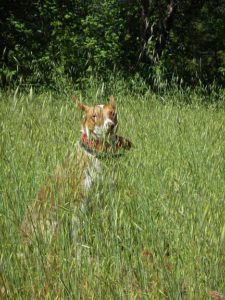
The combination of the foregoing conditions sets the stage for what could be the worst wildfire season ever. Helicopters and tankers are not prevention; and relatively speaking, there has been virtually no reduction in grass and brush fuels, which are the kindling and primary fuels in our wildfires.
It’s a fact that our native species herbivory is severely depleted compared to what it was 5-decades ago…. and so, here we are today; with the gun once again loaded and pointed right at our own heads.
Firefighters (ground crews) like fighting fire with ‘one-foot in the black’ as it is said, ‘black’ being an area depleted of fuels, and fire-grazed areas are the next best thing.
This ABC News video was filmed in the area of our wilderness ranch in May 2018, two months before the deadly Klamathon Wildfire swept into our area. It clearly shows wild horses clearing grass and brush fuels in an area unsuited for livestock due to numerous apex predators. And importantly, they do that year-round in all conditions and areas. The fact that the blowing embers from the wildfire were unable to spot-over the fire-line into this same area is what some may call a most intriguing coincidence… I call it science verified.
This fast moving wildfire was held at-bay on the edge of the area where our local wild horses had grazed (an area devoid of livestock due to functioning trophic cascades with a robust apex predator population).
Consistent with the posits of Oregon State’s Professor William Ripple’s published study, nominal reduction (not total removal) of grass and brush by large-bodied herbivores does, in fact, reduce the frequency and intensity of wildfire on the landscape.
Dr. Ripple’s thesis was empirically proven beyond ANY doubt this past year right on our ranch:
Read his study about the herbivory and fire: “By altering the quantity and distribution of fuel supplies, large herbivores can shape the frequency, intensity, and spatial distribution of fires across a landscape.”
Our ranch and the entire Cascade Siskiyou National Monument over the fence to the north [except about 3,800 acres that burned where the fire spotted over into an un-grazed area) was spared because heroic firefighters were able to hold the line on the edge of an area with less grass and brush fuels than what had been feeding the wildfire in the preceding area. And, the wind that was pushing the fire (20-30 mph) was blowing large hot embers airborne over and across the fire-line hundreds of yards, but due to areas of lesser fuels, the fire had difficulty spotting-over the fire-line.
Make no mistake; I can make this statement because I was personally on the fire-line for 9-days. And having fought small wildfires as a logger back in the late 1960’s and early 1970’s, I know what I was seeing.
Here is just one of several articles I wrote with photos that even news channels didn’t have, which I took:
http://www.myoutdoorbuddy.com/articles/135834/catastrophic-klamathon-wildfire—report-from-the-camp-creek-fire-line-(radio-interview-link-below).php
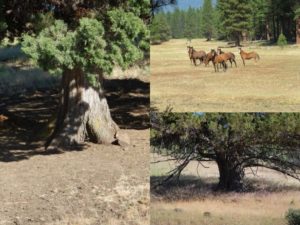
Photo above left side: a conifer that has been used as shelter by wild horses benefits by having grass and brush fuels removed by wild horses, the tree is fertilized by horse droppings (nutrient-rich humus) and the fire ladders are broken-off (~5-feet above ground level) by wild horses rubbing and scratching. This tree has been made fire-resistant by the wild horses. Top right: a family of wild horses has grazed-in a fire-break in the deep wilderness forest providing protection for trees and a potential safe zone for hot-shot firefighters. Lower right: A tree not benefiting from a mutualism with wild horses is seen with fuels and fire-ladders, and is vulnerable to wildfire
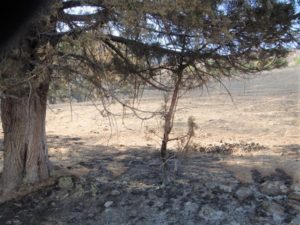
This conifer (above), one of many that survived the deadly Klamathon Wildfire (~38,000 acres) only because the fuels (grass and brush) under and around the tree had been nominally grazed by the local wild horses (Note: there are NO livestock in this area)
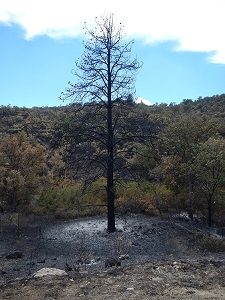
Sadly, this formerly vibrant pine tree was turned into a match stick. This tree was not benefited by and mutualism with wild horses and the grass and brush under the tree kindled the tree into a charcoal pole.
We need to implement smarter tactics or very soon we won’t have any forests left (or wildlife) to worry about, and in the process our economy (which floats ALL boats, even public servants) will tank due to all the primary and secondary costs and losses (not the least of which are huge health care costs due to toxic wildfire smoke, now just being calculated). In 2018, CA wildfires levied $180-Billion in total losses, NOT including costs related to health care, which might match that amount (just my wife’s wildfire smoke mediated neurological disease, which is taking her life, has cost over $1-Million already).
Wilderness areas are manifestly ill-suited to any form of livestock fire-grazing due to difficult access and terrain which adversely impact management and transportation logistics costs, coupled with depredation by robust apex predator populations in these same wilderness areas (I.E. Six Rivers National Forest). In wilderness areas trophic cascades are the longstanding evolutionary means (Natural Selection) for controlling populations of all animals, including equids. We cannot use prescribed burns or mechanical fuel mitigation methods in these wilderness areas, so the tool box is empty without wild horses for these specific yet very important areas.
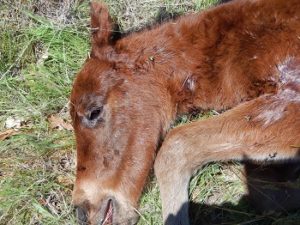
I photographed this foal (attacked at the neck by coyote) that was killed in the first week of May (2019).
In our balanced wilderness ecosystem, only about 1 out of 20 foals born to a lactating mare with stallion will reach 2-years of age. I have abundant forensic data (has been provided over time to our local Ag. Commissioner and Sheriff) showing adults are also taken by mountain lions on a regular basis, so much so that our local herd is in constant slow decline due to depredation, even though resources on the landscape (water and grazing) are abundant and can easily support about 100 more equids, according to my observations and confirmed by our wildlife biologist.
The smoke from out west is impacting populations as far away as the east coast, so this problem affects everyone. The BLM (DOI) and USFS (USDA) must come together and make better use of our excess wild horses than the current taxpayer subsidized confinement model, where they provide no service or value (only costs) to the taxpayers who legally own American wild horses. This in great contrast to the $72,000.00 in value that each horse deployed into wildfire fuel mitigation roles provides; to wit: https://docs.wixstatic.com/ugd/6a30c6_5c93409e81c044d2b0b33a5085f213b0.pdf
Here is my newly published article about the BLM’s old concept (warehousing-sanctuary) model revived again and being proposed to Congress on an even larger more costly scale at great expense to taxpayers: https://www.horsetalk.co.nz/2019/05/01/are-sanctuaries-acceptable-wild-horses/
A new thesis documentary film produced by a graduate student out of Colorado College clearly shows that the longstanding herd of wild horses on our local landscape (evidence in local newspaper of wild horses on this landscape for 200-years) have had no adverse impact on pastures, riparian areas or watershed. Given the area is NOT co-mingled with livestock, there is no ‘who-done-it’ mystery here.
Fuel, Fire and Wild Horses: https://vimeo.com/327282987
Even after 200-years (5-years of which I have documented, along with a wildlife biologist last year), the area is pristine and this new 9-minute natural history documentary film proves, without any doubt that, when wild horses are on a wilderness landscape where there are no livestock present there are NO adverse impacts observed; only benefits to the ecosystem. If we lose our integrity and honor by not acknowledging the truth, than I fear mankind is in deeper trouble than any of us realize.
I am sure you know, we can and must do much better for Americans and ourselves (we all breathe this toxic smoke as do our friends, relatives and in some cases, our own families). We must relocate a useful percentage of wild horses into selected wilderness asap.



